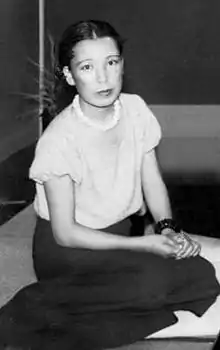Chiyo Uno | |
|---|---|
 | |
| Born | November 28, 1897 Iwakuni, Japan |
| Died | June 10, 1996 (aged 98) Tokyo, Japan |
| Occupation | Writer, magazine editor, kimono designer |
| Notable works | Ohan, Confessions of Love |
Chiyo Uno (Japanese: 宇野 千代, Hepburn: Uno Chiyo, November 28, 1897–June 10, 1996) was a Japanese author and kimono designer. She was known for her contributions to Japanese fashion, film, and literature.
Early years
Uno was born in Iwakuni, Yamaguchi.[1] In 1915, she was fired from her job as a teacher's assistant due to an affair she was having with a colleague.[2] In 1919, she married her cousin, a banker named Fujimara Tadashi.[2][3] Her initial literary success came in 1921 when she was awarded a prize for her short story Shifun no Kao, or Painted Face. After receiving the award, Uno left Tadashi and moved to Tokyo.[2][3]
Like many young Japanese people of the 1920s, Uno was fascinated with American and European culture and dressing. In 1927, she was one of the first women in Japan to bob her hair like a flapper.[1] Beyond hairstyles, Uno also began to pursue the life of a free-spirited woman. She wanted to be a moga, or "modern girl", and not confined to just the role of supportive wife and mother. She became part of the Bohemian world of Tokyo, and had liaisons with other writers, poets, and painters.
Career
In 1933, Uno began publishing the serialized novel Confessions of Love (色ざんげ, Iro zange). The best seller brought her much fame.[4] The novel details an artist and his various love affairs, and a suicide attempt with his mistress.[4] The novel was based on the biography of Seiji Tōgō, an artist with whom Uno had a romantic relationship.[1] Uno was applauded for her ability to write convincingly from the perspective of a man in Confessions of Love, which further added to her book's appeal.[2]
Shortly after the success of Confessions of Love, Uno started a magazine called Sutairu (スタイル), or Style, in 1936. The magazine was the first in Japan to focus on foreign fashions.[1] Sutairu took up much of her time through the following decades until its bankruptcy in 1959.[2]
Uno continued to write and intrigue an audience of Japanese women, who found a sense of liberation in Uno's prose. Even if Uno's readers remained within conventional boundaries themselves, they could escape briefly through her stories of lovers and entanglements. Throughout her literary career, she was praised for her ability to write skillfully from both male and female perspectives.
Uno also became successful as a kimono designer, and along with her assistant designer Tomiyo Hanazawa, Uno traveled to the United States to stage the first kimono fashion show in the United States in 1957.[2]
Later years
In later years, Uno's popularity was given formal status as she was recognized by the Emperor and assumed the honor of being one of Japan's oldest and most talented female writers.[1] In 1983 she published the memoir I Will Go On Living (Ikite yuku watakushi), which was widely read and adapted for television.[1] She was named a "person of cultural merit" in 1990.[1]
She stated that the essence of her life was not to follow anyone else's rules and to have done as she pleased. Uno married multiple times with varying levels of success, as she found it difficult to remain with just one man, and it was said that she would even move to a new house every time a major affair or marriage ended.
Works
- Confessions of Love, 1933-1935[4]
- Ningyoshi Tenguya Kyukichi (The Puppet Master Tenguya Kyukichi), 1942[2]
- Ohan, 1957[2]
- Sasu (To Sting), 1964[2]
- Kaze no Oto (The Sound of the Wind), 1969[2]
- Kofuku (Blessings), 1970[2]
- The Story of a Single Woman, 1972[5]
- Mama no Hanashi (Mama-san's Story), 1976[2]
- Cheri ga Shina (Cherry is Dead), 1976[2]
- I Will Go On Living, 1983[1]
- Ippen Harukaze ga Fuitekita (Suddenly a Spring Wind), 1987[2]
Awards and honors
- 1957, Noma Literary Prize
References
- 1 2 3 4 5 6 7 8 9 "Chiyo Uno, Japanese writer". Tampa Bay Times. 11 June 1996. Retrieved 2022-12-30.
- 1 2 3 4 5 6 7 8 9 10 11 12 13 14 Copeland, Rebecca L (April 1988). "Uno Chiyo: Not Just "A Writer of Illicit Love"". Japan Quarterly. 35 (2). ProQuest 234908386 – via ProQuest.
- 1 2 3 "Chiyo Uno, 98, Writer Whose Loves Shook Japan". The New York Times. Associated Press. 1996-06-12. ISSN 0362-4331. Retrieved 2022-12-30.
- 1 2 3 "Chiyo Uno, lo salvaje del amor salvaje". ELMUNDO (in Spanish). 2019-10-07. Retrieved 2022-12-30.
- ↑ Mansfield, Stephen (2020-06-20). "'The Story of a Single Woman': A frank, unsentimental gaze at past loves". The Japan Times. Retrieved 2022-12-30.
External links
- Prominent People of Minato City Chiyo Uno (in English)
- Synopsis of Ohan at JLPP (Japanese Literature Publishing Project) (in English)
- The Sound of the Wind: The Life and Works of Uno Chiyo. Rebecca L. Copeland (1992)